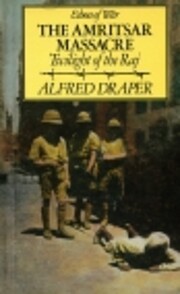

Clique em uma foto para ir ao Google Livros
|
Carregando... The Amritsar Massacre: Twilight of the Rajde Alfred Draper
 Nenhum(a) Ainda não há conversas na Discussão sobre este livro. sem resenhas | adicionar uma resenha
Não foram encontradas descrições de bibliotecas. |
Current DiscussionsNenhum(a)
 Google Books — Carregando... Google Books — Carregando...GênerosClassificação decimal de Dewey (CDD)954.0357History and Geography Asia India and South Asia 1785–1947 British rule 1858–1947 Control by Crown 1916–1926Classificação da Biblioteca do Congresso dos E.U.A. (LCC)AvaliaçãoMédia: (3) (3)
É você?Torne-se um autor do LibraryThing. |
|||||||||||||||||||||||||||||||||||||||||||||||||||||||||||||||||||||||||||||||||||||||||||||||||||||||
There were in fact two massacres that horrible day – in the first the enraged Amritsar mob ran amok, burnt three banks, murdered all the Europeans they found and burned the documents, furniture and the British staff in fires set on the streets. They abused and severely beat two English women they trapped … distressingly both had spent their lives in the Punjab helping the poor.
The second massacre, at a proscribed political meeting in the walled-park, was perpetuated by the British forces and was far more deadly with around 397 (officially stated) deaths and many hundreds of wounded. Indian claims state that it was more like 2,000 victims.
Quite unaware that the immediate approval of his Lieutenant Governor (Sir Michael O’Dwyer) was unofficial and later denied, the stiff soldier truthfully and innocently condemned himself at the subsequent hearings. "I think it quite possible” stated Dyer” that I could have dispersed the crowd without firing but they would have come back again and laughed, and I would have made, what I consider, a fool of myself." Forcibly retired and sent home in disgrace and under censure Dyer was championed by many as a political ‘scapegoat’.
Draper, in this very readable history, at one point, says that many thought O’Dwyer suffered only the mildest of rebukes … until 1940, when at a meeting in Caxton Hall, a Sikh extremist Udham Singh who had actually been present at the rally, shot and killed O'Dwyer, blaming him for the massacre as he had been the Lieutenant-Governor of Punjab at the time.
In 1984, some sixty years later, similar uprisings and unlawful assemblies in the Punjab led to another military intervention and the leader, Mrs. Indira Gandhi, suffered the same fate as her predecessor in the Punjab and was also assassinated by an avenging Sikh.
Dyer and his supporters always held that his actions ”my horrible duty” saved India from another mutiny, instead Draper shows that it led to independence under Gandhi’s guidance and leadership and “it popped out the jewel from the crown”.